[ad_1]
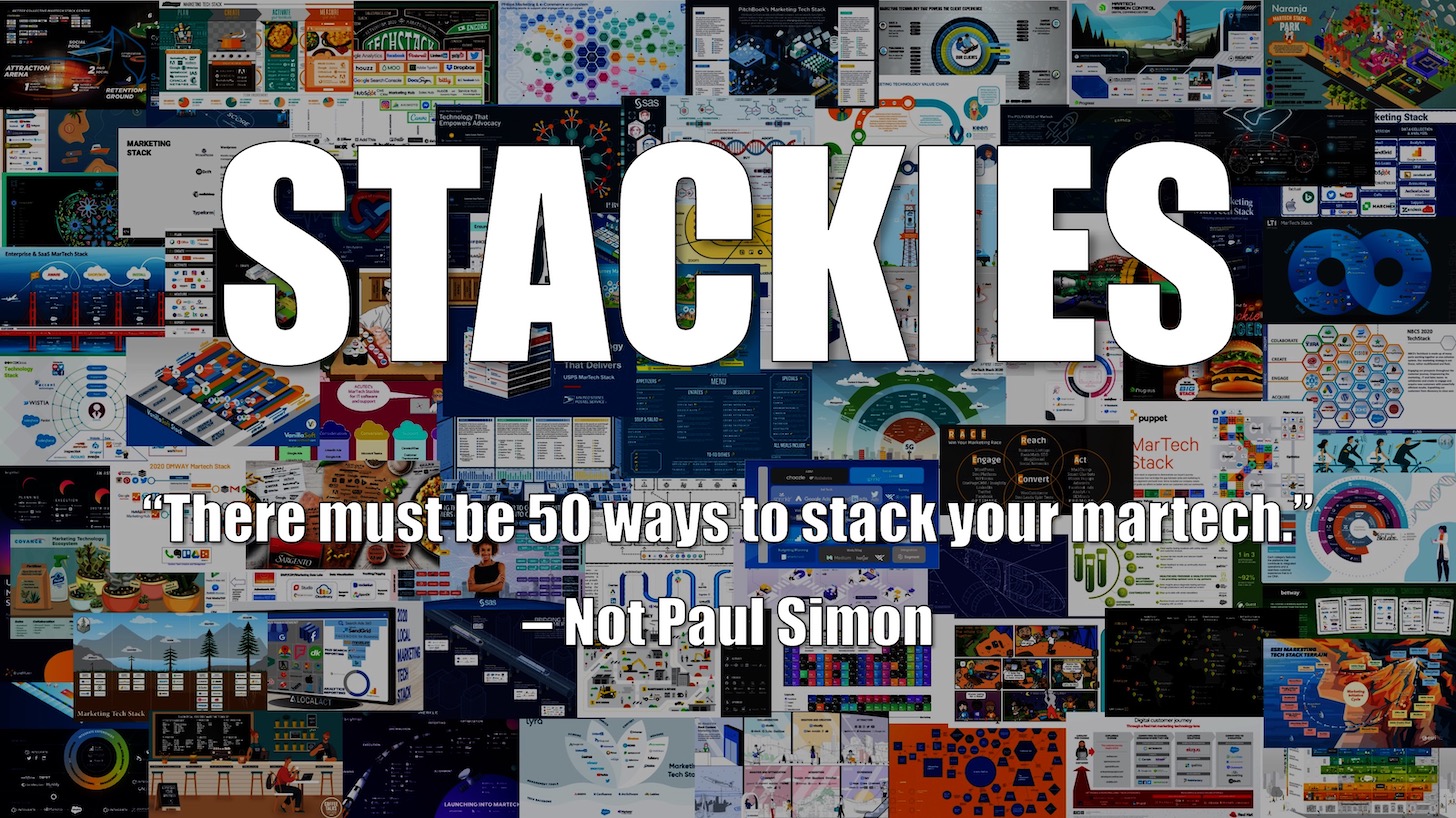
This is the 8th calendar year we’re working The Stackies. It is an awards software that invites entrepreneurs to share a single slide illustrating their martech stack — the different applications and platforms they use and how they conceptualize them doing work jointly.
I’d inspire you to take part (deadline for entries April 29). It is a wonderful way to add to our community’s comprehending of how martech fits into the perform and move of fashionable promoting.
However, even if you hardly ever share your stack outdoors the walls of your corporation, illustrating it can be an exceptionally handy exercising to far better fully grasp it — and be in a position to make clear it to other stakeholders.
So what is the most effective way to illustrate your stack?
Turns out there are a lot of strategies, each individual bringing a unique lens. Acquiring reviewed hundreds of entries to The Stackies in excess of the a long time — here are all of them from 2015, 2016, 2017, 2018, 2019, 2020, and 2021 — I’ve distilled 10 styles that I’ve found on their possess and in mixture alongside one another.
1. Vendor Class Map
Usually using the taxonomy from our advertising and marketing know-how landscape, martech applications are structured into their products types and subcategories. It displays your stack as a result of the lens of a seller sector map and identifies the products and solutions you have selected. This is a good way to analyze your general stack inventory and present the span of martech alternatives.
Here’s an case in point from SAS and their 2021 Stackie entry:
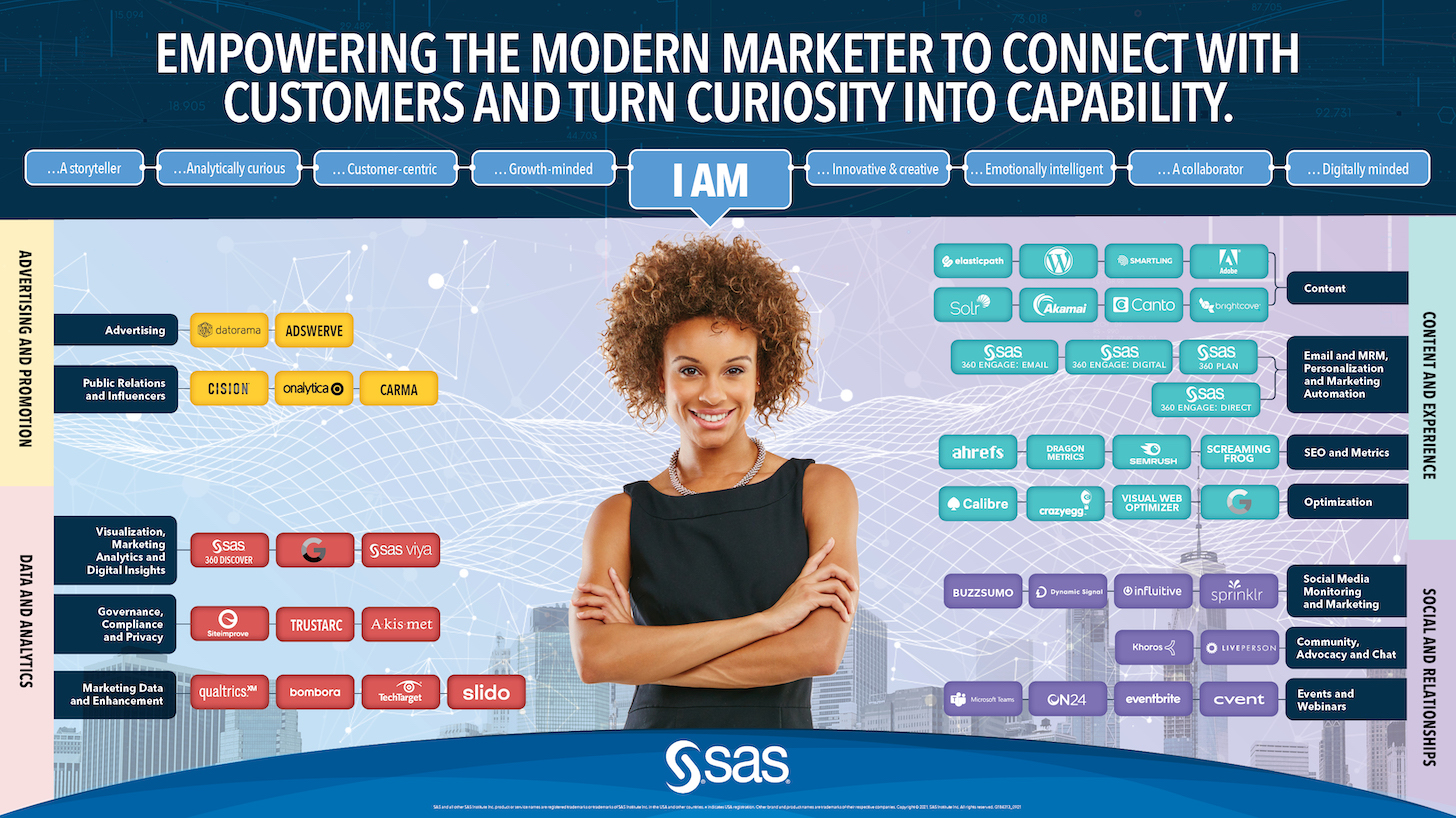
2. Client Journey Map
An additional common design is to align your martech stack towards various stage of the customer’s journey. Typically for entries to The Stackies, the journey is simplified into 4-5 phases, such as Explore, Think about, Obtain, Onboard, and Expand.
This terrific illustration from Juniper Networks and their 2021 Stackie entry illustrates two proportions: the buyer journey horizontally and the seller types utilised vertically:
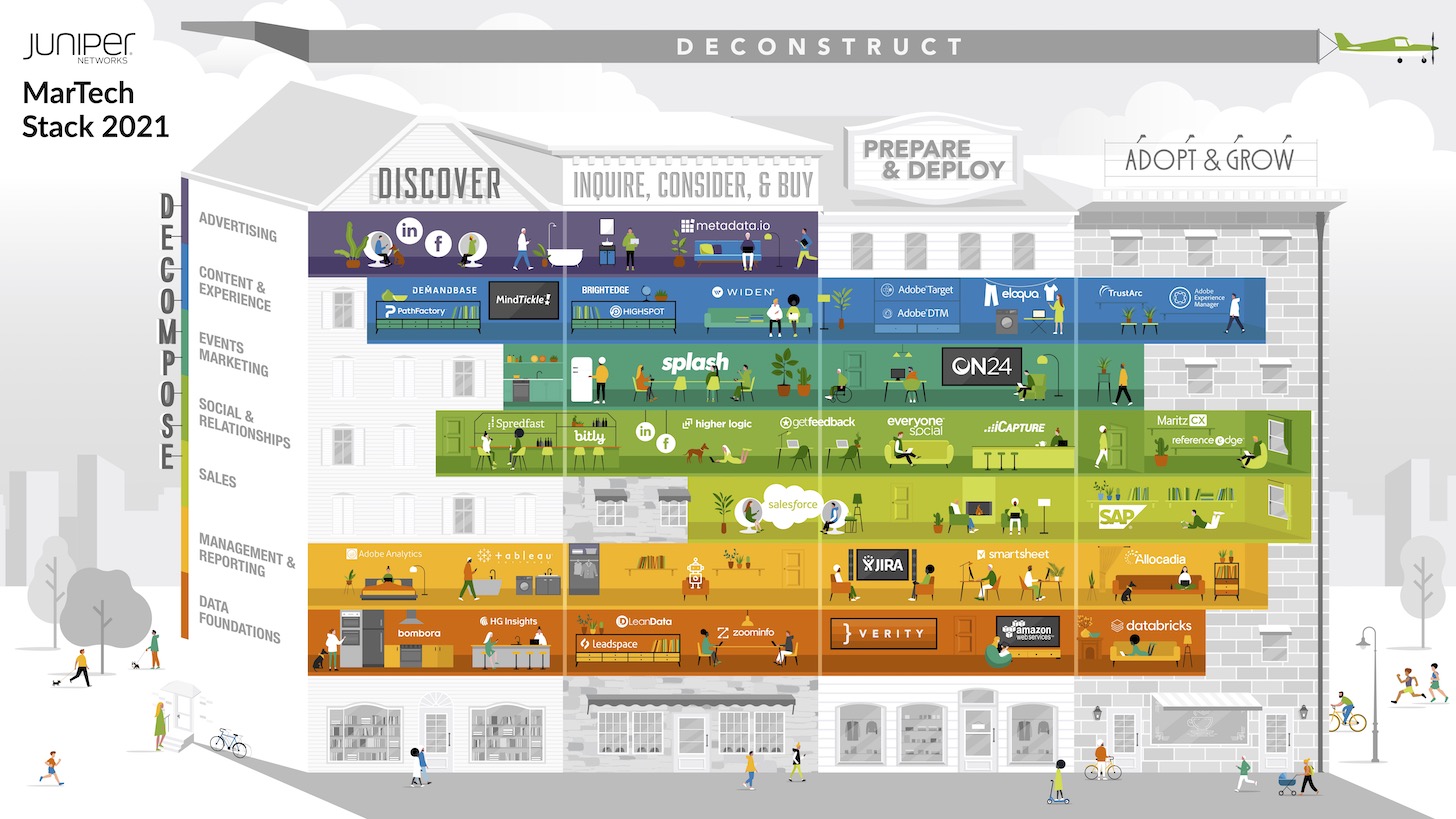
3. Back again-Stage vs. Entrance-Phase
Yet another way of on the lookout at your stack is by way of a theater metaphor: again-stage and front-phase apps and platforms. Front-phase applications straight contact the purchaser — e.g., world wide web experiences, email campaigns, social media engagement equipment, promoting, and so forth. Back-phase applications are used to provide inner stakeholders, these as analytics, arranging, asset administration, productiveness, and many others.
This is an stylish illustration from Pink Wing Shoes and their 2017 Stackie entry, with back-phase to entrance-stage categorization together the vertical accessibility and customer journey phase alongside the horizontal axis:

4. Perform or Function-Based mostly Map
Though martech stacks can be really huge, any just one human being in the internet marketing office is unlikely to have to understand all of the apps in just it. Different roles in marketing and advertising will use distinct tools. So an additional beneficial way of mapping your martech stack is to team apps by the roles or functions that use them. This is reveals the “who” dimension of your stack, which is handy to see the interrelation concerning apps, skills, and results.
This case in point from Bigtincan’s 2019 Stackie entry illustrates three key roles: web management, marketing automation, and information advertising:
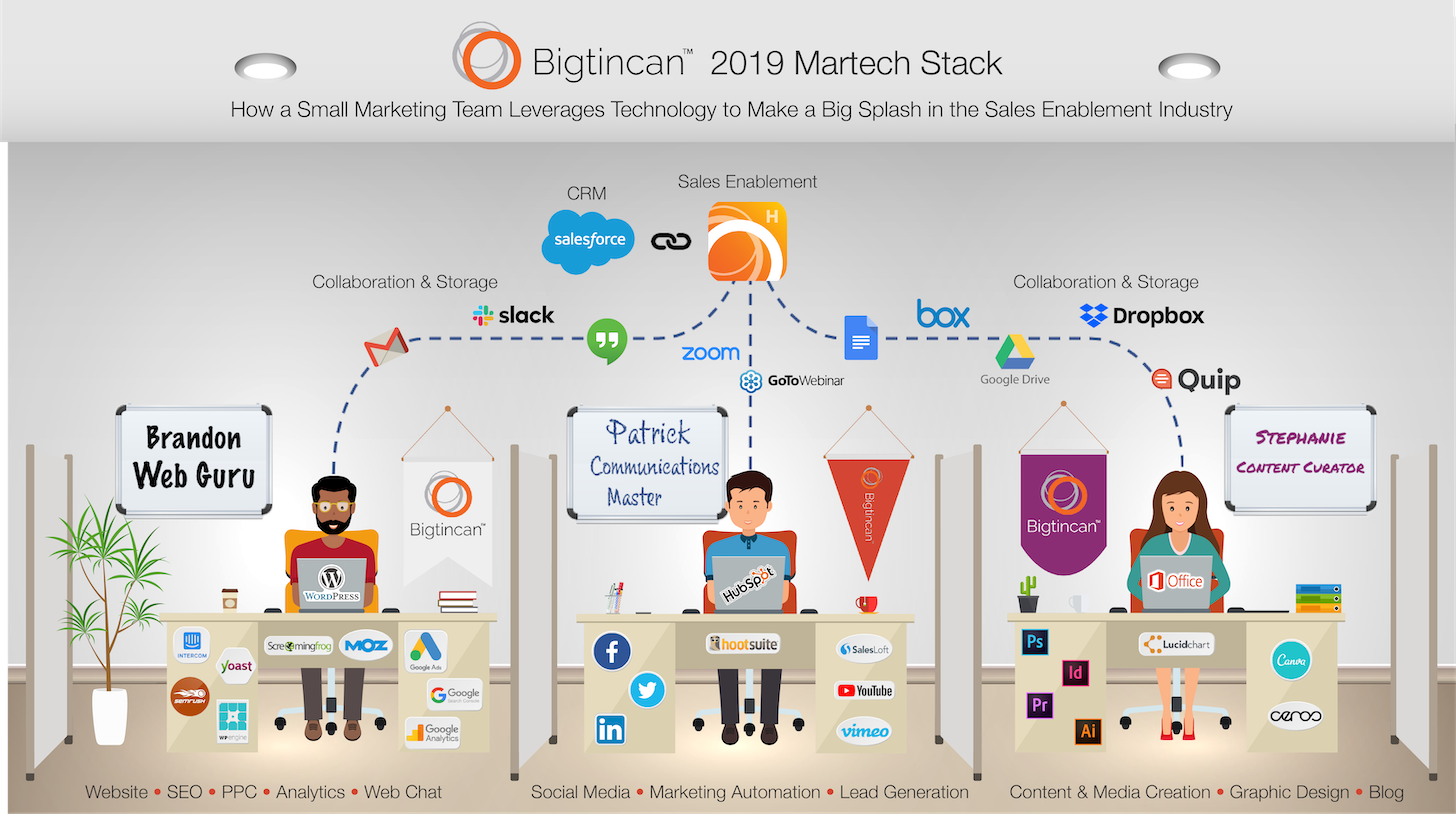
5. Place Option/System Ecosystem Map
Integration is vital to an efficient martech stack. A further fantastic way to visually analyze your stack is to clearly show the system(s) that are the gravitational heart(s) of your martech stack and which professional apps combine to just about every of them. It’s an ecosystem perspective of your stack.
This illustration from Poly’s 2020 Stackie entry truly captures 5 diverse proportions, which includes relative financial investment, compensated/attained/owned answers, seller group — and identifies platforms, built-in specialist applications, and stand-by itself issue methods:

6. Use Map (Relative Time in Applications)
Some martech applications are utilized frequently, as an integral aspect of marketing’s day-to-working day functions. Other apps, however, are much more specialized and made use of a lot less commonly. This doesn’t signify they’re not precious. They just have a time and location for their goal. Figuring out greatly-used main equipment vs. frivolously-made use of tools professionals can be another insightful way to recognize the composition of your stack.
This example from Airstream’s 2019 Stackie entry cluster applications generally by their use situation — planning, artistic, engagement, supplier channel, and measurement — but the height of the pine tree icons represents the relative time entrepreneurs spend interacting with each individual resource:
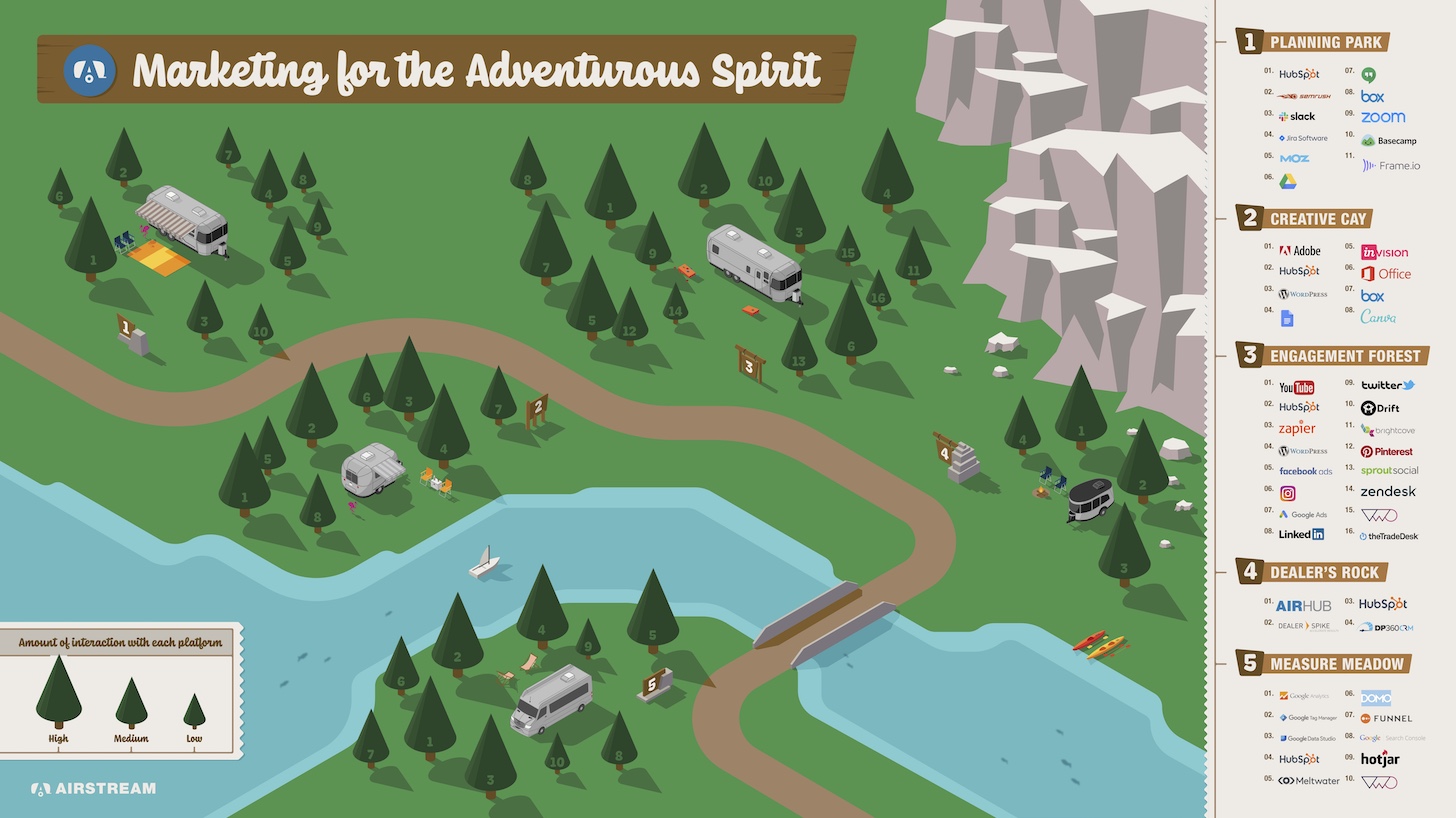
7. Relative Diploma of Automation
Even though thinking of the quantity of time that buyers expend engaged with diverse resources in your stack, it is an fascinating lens to examine how automated people equipment are. Which instruments are employed typically manually? Which kinds have substantial automations? This perspective can be valuable equally to fully grasp the partnership concerning equipment and internet marketing course of action and functions. It can also aid identify chances to automate.
Automation is the largest frontier in Large Ops in my opinion.
This illustration from Paychex’s 2019 Stackie entry maps out their martech apps on two dimensions: different advertising and marketing capabilities and the diploma to which they are automated:

8. Tempo Layering of Platforms and Applications
About a ten years ago, as tech stacks in standard — not just martech — had been expanding fast, Gartner proposed a way to arrange them by “speed layer.” They suggested a few levels: techniques of report, programs of differentiation, and units of innovation.
Methods of document should be incredibly secure and have a gradual speed of modify. They are the platforms on which other application and services count. Methods of differentiation embody the procedures and activities that make your business enterprise exceptional. They improve much more regularly, but are continue to rather secure. Methods of innovation are much more experimental, the area where new abilities can be designed and piloted quickly.
A single of the most effective Stackie entries was this a single from Microsoft in 2017, which mapped tools together the infinite loop of purchaser journeys, but then also separated them into Gartner’s three pace layers:

9. Evolution of Martech Equipment Above Time
Martech stacks don’t stand even now. New tools are included. Aged instruments are changed. This is element of the normal evolution of a organization as it grows — and as the broader internet marketing and martech environment proceeds to change all around it. It can be beneficial to analyze your martech stack by way of the lens of its changing app stock over time.
This case in point, sent in by reader John Schott in 2017, shows a five-yr journey of a tiny fiscal providers organization:

10. Linked Capabilities Map
At the intersection of groups and resources, abilities are produced. Somewhat than looking at your stack by way of the lens of vendor types, you can organize a view all over distinctive capabilities, this kind of as marketplaces, user-generated written content, information syndication, qualitative and quantitative exploration, and so forth. Mapping these capabilities in clusters, to display their adjacencies and associations with every single other gives you a photograph of the ecosystem close to your stack.
This 2021 Stackie entry from Philips is a fantastic case in point:

Other Approaches to Map Your Stack
Of study course, there are lots of other methods to visualize other proportions of your stack.
For instance, you may organize it about aggregation technologies within your martech stack. How are you horizontally aggregating info, workflow, practical experience, and governance throughout numerous different apps, data sources, and buyer touchpoints? Which instruments are you applying to vertically integrate those people levels in specific domains, this kind of as CRM?
Alternatively, you could possibly illustrate your stack to emphasize the degree of customization within different apps and platforms. They might selection of purely out-of-the-box professional applications, to packaged products that have been tailored or extended with your possess code, to fully custom applications that are exclusive to your enterprise.
Every single of these distinct ways can give you unique insights into the nature of your stack — and aid you communicate them to stakeholders throughout your business.
What does your martech stack appear like?
Reminder: Even if you never enter The Stackies yourself — whilst we certainly hope you do — really don’t forget to indicator up for the free of charge webinar on #MartechDay, Could 3. We’ll be unveiling the new 2022 martech landscape, releasing a Condition of Martech report, and celebrating the entrants and winners of this year’s Stackie Awards.
[ad_2]
Source backlink




